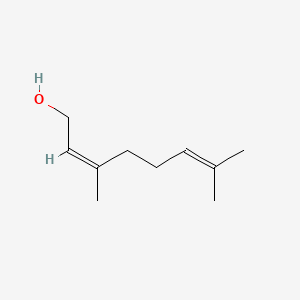| Authors | Title | Published | Journal | PubMed Link |
|---|---|---|---|---|
| Nowotarska SW et al. | Effect of structure on the interactions between five natural antimicrobial compounds and phospholipids of bacterial cell membrane on model monolayers. | 2014 | Molecules | pmid:24914896 |
| de Menezes-Filho JE et al. | Geraniol blocks calcium and potassium channels in the mammalian myocardium: useful effects to treat arrhythmias. | 2014 | Basic Clin. Pharmacol. Toxicol. | pmid:24862086 |
| Chen M et al. | Use of synthetic isoprenoids to target protein prenylation and Rho GTPases in breast cancer invasion. | 2014 | PLoS ONE | pmid:24587105 |
| Liang D et al. | Construction of the 1,2-dialkenylcyclohexane framework via Ireland-Claisen rearrangement and intramolecular Barbier reaction: application to the synthesis of (±)-Geijerone and a diastereoisomeric mixture with its 5-epimer. | 2014 | Molecules | pmid:24448064 |
| Kubo K et al. | Synthesis and properties of cholesteryl 4-(Alkanoylamino)benzoates: liquid crystals and organogelators. | 2014 | J Oleo Sci | pmid:24599108 |
| Ramilijaona J et al. | Enzymatic modification of palmarosa essential oil: chemical analysis and olfactory evaluation of acylated products. | 2013 | Chem. Biodivers. | pmid:24327448 |
| Paterson A et al. | Environmental and seasonal influences on red raspberry flavour volatiles and identification of quantitative trait loci (QTL) and candidate genes. | 2013 | Theor. Appl. Genet. | pmid:22890807 |
| Tian J et al. | Investigations on the antifungal effect of nerol against Aspergillus flavus causing food spoilage. | 2013 | ScientificWorldJournal | pmid:24453813 |
| Bouzenna H and Krichen L | Pelargonium graveolens L'Her. and Artemisia arborescens L. essential oils: chemical composition, antifungal activity against Rhizoctonia solani and insecticidal activity against Rhysopertha dominica. | 2013 | Nat. Prod. Res. | pmid:22840199 |
| Boukhatem MN et al. | Rose geranium essential oil as a source of new and safe anti-inflammatory drugs. | 2013 | Libyan J Med | pmid:24103319 |
Nerol
Nerol is a lipid of Prenol Lipids (PR) class. The involved functions are known as Odorant, Anabolism, Diastasis, Metabolic Inhibition and Oxidation. Nerol often locates in germ tube. The related lipids are Octanols, Pinene, Hexanols, ethyl butyrate and ethyl hexanoate.
Cross Reference
Introduction
To understand associated biological information of Nerol, we collected biological information of abnormalities, associated pathways, cellular/molecular locations, biological functions, related genes/proteins, lipids and common seen animal/experimental models with organized paragraphs from literatures.
What diseases are associated with Nerol?
There are no associated biomedical information in the current reference collection.
No disease MeSH terms mapped to the current reference collection.
PubChem Associated disorders and diseases
What pathways are associated with Nerol
There are no associated biomedical information in the current reference collection.
PubChem Biomolecular Interactions and Pathways
Link to PubChem Biomolecular Interactions and PathwaysWhat cellular locations are associated with Nerol?
Visualization in cellular structure
Associated locations are in red color. Not associated locations are in black.
Related references are published most in these journals:
| Location | Cross reference | Weighted score | Related literatures |
|---|
What functions are associated with Nerol?
Related references are published most in these journals:
| Function | Cross reference | Weighted score | Related literatures |
|---|
What lipids are associated with Nerol?
Related references are published most in these journals:
| Lipid concept | Cross reference | Weighted score | Related literatures |
|---|
What genes are associated with Nerol?
There are no associated biomedical information in the current reference collection.
What common seen animal models are associated with Nerol?
There are no associated biomedical information in the current reference collection.
